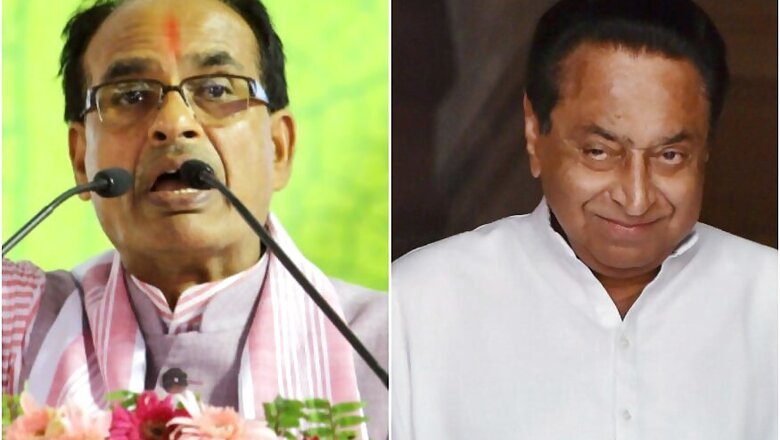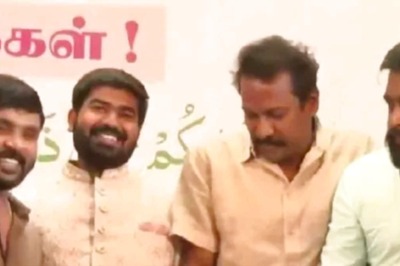
views
Ahead of the Lok Sabha elections, the Madhya Pradesh assembly polls in 2013 were part of the poll-cycle which marked the beginning of a winning streak for the Bharatiya Janata Party, helping it wrest power from the Congress at the Centre by a thumping majority. The BJP won a two-thirds majority in the state and formed government for the third consecutive time.
But five years later, the Congress has turned the heat on Shivraj Singh Chouhan government by taking up issues of farmers, women, youth, inflation, and corruption. The party is hoping to make a dent into BJP’s vote share and form a government in the state after being in opposition for 15 years.
Let us look at statistics from past elections to extrapolate how electorate might have voted this time around.
High Voter Turnout Helps BJP
After the 75% turnout in Madhya Pradesh, the highest in an Assembly election in the state so far, many might have believed, and as the common perception goes - that anti-incumbency in the state and a high voter turnout could favour the opposition.
However, contrary to the belief, this high voter turnout or voting percentage in Madhya Pradesh is not an adequate indicator of the anti-incumbency wave in the state. On the contrary, though, past trends from the earlier elections reveal that a change in voter turnout mostly helps the BJP.
For example, of the 17 states that elected a new government since May 2014, 10 states recorded increased voting percentage. The BJP benefited in the assembly elections in seven of these states.
In Maharashtra, voting percentage improved from 60% in 2009 assembly election to 64 per cent in 2014 polls. The BJP emerged as the single-largest party falling 22 short of majority but replaced the Congress as the ruling party in Maharashtra after the polls.
In Haryana, voting percentage increased to 76.9% in 2014 assembly polls a record for the state from 72.29% in 2009 election. The BJP won a majority on its own and ousted the Congress from power in Haryana.
The election results in Jharkhand were also somewhat similar. The voting percentage in Jharkhand improved by nearly 6.5% points to 66.03% in 2014 from 59.40 in 2009 assembly election. The BJP defeated the Congress and its allies the RJD, JD(U) and the JMM.
In Jammu and Kashmir also, when the state went to polls in 2014, the election saw increase in voting percentage from 60.4% in 2008 to 65.23% in 2014. It ended in a hung assembly but the BJP gained in the Jammu region winning 25 seats in the state assembly, later forming a government with the People’s Democratic Party that ended a couple of months ago.
And if one looks at the reverse of it, when the voter turnout has been less than the earlier election year, the BJP has found itself in a tight spot. This was witnessed during the Gujarat election when the BJP saw its seat share fall from 115 in 2012 to 99 in 2017. That year the voter turnout dipped by 3% to 68.41% in the state compared to the 2012 polls when 71.32% polling was registered.
If this trend of increase in voter turnout continues, the BJP could have an advantage.
The Widening Vote Share Gap and Winning Margins
In Madhya Pradesh, both BJP and the Congress increased their vote share in the 2013 assembly election. The Congress saw an increase of 3.97% in its vote share, the BJP recorded a vote percentage of 44.87 %, surpassing its previous high of 42.5% in 2003.
This gap of 9% points higher than Congress’s also helped the BJP to convert the vote share into more seats. For every seat won, the BJP needed close to 92,000 votes, less than half of the Congress figure of 212,300.
In 2013, the BJP also had higher victory margins on average. Of the 165 seats it won in the 230-member assembly, the BJP had a victory margin greater than 10% in more than 90 constituencies. In contrast, the Congress won only 17 of the 58 constituencies with a victory margin greater than 10%.
These high margin victories for the BJP were equally distributed in reserved and unreserved constituencies of the state which play an important in the government formation in the state.
The party also secured 31 of the 47 scheduled tribes (STs) seats.
However, the recent controversy over the Scheduled Caste and Scheduled Tribe (Prevention of Atrocities Act) could threaten BJP’s prospects in Dalit dominated constituencies.
The Curious Case of Upper Caste Voters and Urban Votes
While controversy over Dalit Atrocities Act may effect BJP's prospects in among the SCs the BJP’s core upper caste vote bank has been disrupted by emergence of Samanya Picchdaa Evam Alpsankhyak Samaj, which fielded candidates in many constituencies.
Data from pre-poll surveys conducted by Lokniti-CSDS suggests that a large majority of upper caste voters support the BJP in Madhya Pradesh. The current restiveness among them could signal trouble for the party.
Yet, the biggest challenge for the party would be to lure the urban voters of the state.
During the 2017 Gujarat elections, it was urban seats which saved the BJP in the state. The Congress won a majority in rural areas, winning 67 out of the 126 rural seats in the state. However, in Madhya Pradesh urban population is only 28%, according to the 2011 census. The figure was 43% for Gujarat.
This trouble for the BJP was also indicated in the local body elections too. Just three months ago, the Congress won nine of 14 municipal seats in Madhya Pradesh for which by-polls were held, gaining three seats.
The ruling BJP won only four and one seat went to an independent. This was the fourth straight loss for the BJP in by-polls in the state across municipal bodies and assembly constituencies in the past year.
However, these by-poll results may not necessarily reflect the people’s mood as they are fought on a much smaller scale and dominated by local issues.
Silver Lining for Congress in The Rural Distress
The rural distress factor could have a much bigger electoral impact in Madhya Pradesh than it had in Gujarat. Only 40 out of the 230 assembly constituencies in Madhya Pradesh are notified as urban. The remaining seats fall under semi-urban or rural constituencies.
According to the data by the Trivedi Centre for Political Data (TCPD) at Ashoka University, the BJP had a strike rate of 69% in rural seats in the 2013 elections compared to that of a staggering 93% in urban seats.
Similar to what was seen in Gujarat, this widespread rural distress in the state, is likely to add to the anti-incumbency levels for the ruling party.
This time around, the Congress has also led the campaign with issues of farmers’ unrest, unemployment among youth, insecurity among women, poor state of industries, corruption and goods and services tax (GST) on the small trading community, which has been traditional voters of the BJP. Congress’s announcement of Rs 2 lakh agricultural loan waiver can further lure the farming society towards the party.
This Congress’s biggest hope to gain from the rural distress would be in the Malwa-Nimar region that sends 66 legislators to the 230-member state assembly. In the 2013 elections, the Congress won just 9 out of these 66 seats.
That’s why, perhaps, the results from the CSDS-Lokniti opinion polls released earlier this month predict a tight contest. The BJP is likely to win in 116 seats with a vote share of 41%, leaving the Congress behind at 105 seats with a vote share of 40%, the survey showed. In the 2013 elections, the BJP had won commandingly with 165 seats, leaving the Congress far behind with just 58 seats.
This could only mean that the deciding factor in the Madhya Pradesh would be the (much expected) tilt of 1-2% vote share. Whichever way this 1-2% vote share goes; that party is surely to win.


















Comments
0 comment